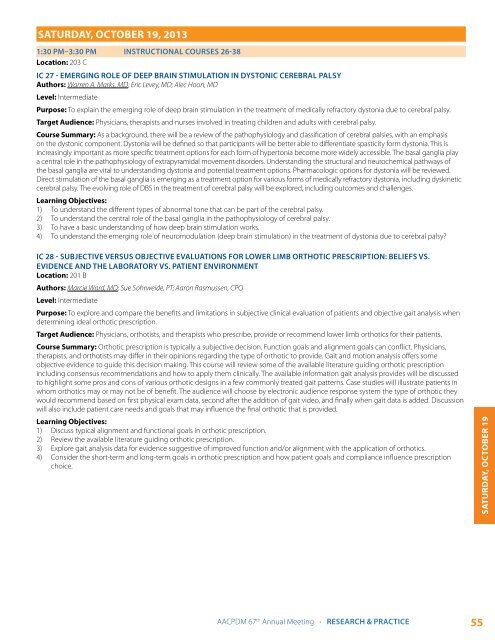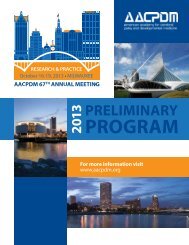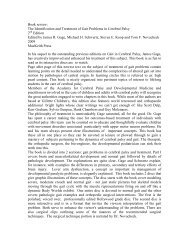ProgrAm - American Academy for Cerebral Palsy and ...
ProgrAm - American Academy for Cerebral Palsy and ...
ProgrAm - American Academy for Cerebral Palsy and ...
- No tags were found...
You also want an ePaper? Increase the reach of your titles
YUMPU automatically turns print PDFs into web optimized ePapers that Google loves.
Saturday, October 19, 20131:30 pm–3:30 pm Instructional Courses 26-38Location: 203 CIC 27 - EMERGING ROLE OF DEEP BRAIN STIMULATION IN DYSTONIC CEREBRAL PALSYAuthors: Warren A. Marks, MD; Eric Levey, MD; Alec Hoon, MDLevel: IntermediatePurpose: To explain the emerging role of deep brain stimulation in the treatment of medically refractory dystonia due to cerebral palsy.Target Audience: Physicians, therapists <strong>and</strong> nurses involved in treating children <strong>and</strong> adults with cerebral palsy.Course Summary: As a background, there will be a review of the pathophysiology <strong>and</strong> classification of cerebral palsies, with an emphasison the dystonic component. Dystonia will be defined so that participants will be better able to differentiate spasticity <strong>for</strong>m dystonia. This isincreasingly important as more specific treatment options <strong>for</strong> each <strong>for</strong>m of hypertonia become more widely accessible. The basal ganglia playa central role in the pathophysiology of extrapyramidal movement disorders. Underst<strong>and</strong>ing the structural <strong>and</strong> neurochemical pathways ofthe basal ganglia are vital to underst<strong>and</strong>ing dystonia <strong>and</strong> potential treatment options. Pharmacologic options <strong>for</strong> dystonia will be reviewed.Direct stimulation of the basal ganglia is emerging as a treatment option <strong>for</strong> various <strong>for</strong>ms of medically refractory dystonia, including dyskineticcerebral palsy. The evolving role of DBS in the treatment of cerebral palsy will be explored, including outcomes <strong>and</strong> challenges.Learning Objectives:1) To underst<strong>and</strong> the different types of abnormal tone that can be part of the cerebral palsy.2) To underst<strong>and</strong> the central role of the basal ganglia in the pathophysiology of cerebral palsy.3) To have a basic underst<strong>and</strong>ing of how deep brain stimulation works.4) To underst<strong>and</strong> the emerging role of neuromodulation (deep brain stimulation) in the treatment of dystonia due to cerebral palsy?IC 28 - SUBJECTIVE VERSUS OBJECTIVE EVALUATIONS FOR LOWER LIMB ORTHOTIC PRESCRIPTION: BELIEFS VS.EVIDENCE AND THE LABORATORY VS. PATIENT ENVIRONMENTLocation: 201 BAuthors: Marcie Ward, MD; Sue Sohrweide, PT; Aaron Rasmussen, CPOLevel: IntermediatePurpose: To explore <strong>and</strong> compare the benefits <strong>and</strong> limitations in subjective clinical evaluation of patients <strong>and</strong> objective gait analysis whendetermining ideal orthotic prescription.Target Audience: Physicians, orthotists, <strong>and</strong> therapists who prescribe, provide or recommend lower limb orthotics <strong>for</strong> their patients.Course Summary: Orthotic prescription is typically a subjective decision. Function goals <strong>and</strong> alignment goals can conflict. Physicians,therapists, <strong>and</strong> orthotists may differ in their opinions regarding the type of orthotic to provide. Gait <strong>and</strong> motion analysis offers someobjective evidence to guide this decision making. This course will review some of the available literature guiding orthotic prescriptionincluding consensus recommendations <strong>and</strong> how to apply them clinically. The available in<strong>for</strong>mation gait analysis provides will be discussedto highlight some pros <strong>and</strong> cons of various orthotic designs in a few commonly treated gait patterns. Case studies will illustrate patients inwhom orthotics may or may not be of benefit. The audience will choose by electronic audience response system the type of orthotic theywould recommend based on first physical exam data, second after the addition of gait video, <strong>and</strong> finally when gait data is added. Discussionwill also include patient care needs <strong>and</strong> goals that may influence the final orthotic that is provided.Learning Objectives:1) Discuss typical alignment <strong>and</strong> functional goals in orthotic prescription.2) Review the available literature guiding orthotic prescription.3) Explore gait analysis data <strong>for</strong> evidence suggestive of improved function <strong>and</strong>/or alignment with the application of orthotics.4) Consider the short-term <strong>and</strong> long-term goals in orthotic prescription <strong>and</strong> how patient goals <strong>and</strong> compliance influence prescriptionchoice.Saturday, October 19AACPDM 67 th Annual Meeting • Research & Practice 55







